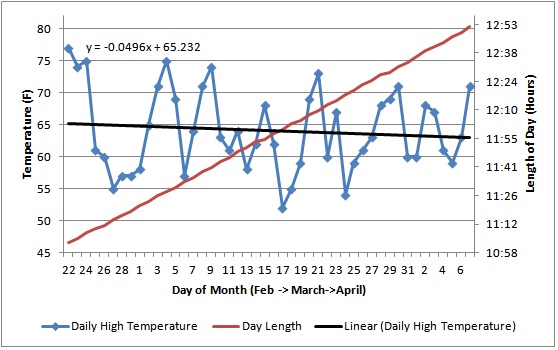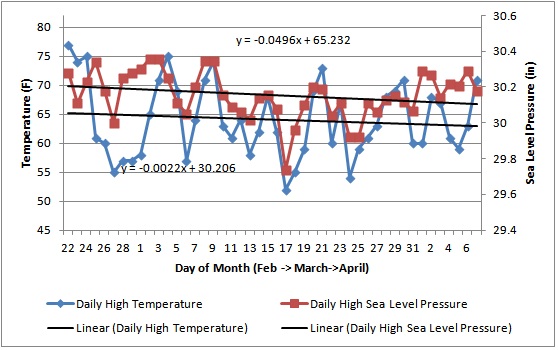Data Contradicts Connection Between Earth's Tilt and the Seasons
Posted on 12 April 2012 by ptbrown31
***The following is a satirical argument intended to highlight some basic errors often made in the climate change debate. Also, I want to show how easy it can be to fool ourselves with real data. The subjects that are touched on are 1) signal-to-noise ratio issues in the Earth's climate system (also discussed here and here, for example) and 2) the fallacy of inferring causality from correlation without evoking physics (also discussed here and here). Those who follow the global warming debate will immediately recognize the similarity to arguments that short-term cooling during a CO2 increase disproves human-caused warming.***
For years we have been told that the Earth's tilt and the associated changes in incoming solar radiation are the cause of the seasons. Scientists have claimed that it is "settled science" that during spring, the day length increases and the sun gets higher in the sky at noon. According to the theory, this should cause the Northern Hemisphere to warm from Feburary through April. However, if this science is so "settled", then why is it easily refuted with empirical evidence?
I live in San Jose, California. The blue curve in figure 1 shows the daily high temperature that we experienced between February 22nd and April 7th. I have also plotted the amount of daylight for each date in question. Notice that we experienced an overall downward trend in temperature over this time period while the length of daylight steadily increased. This is precisely the opposite of what the 'tilt theory' of seasons claims. The data proves the theory invalid!

Figure 1 – Daily high temperature versus length of day in San Jose, California from February 22nd to April 7th 2012.
So if the day length does not have an effect on local temperatures what does? Figure 2 shows the same temperature data displayed in figure 1 but with the daily high sea level pressure overlaid in red. Immediately we can recognize a strong relationship between these two variables. As sea level pressure decreased over this time period, it caused temperature to do the same.

Figure 2 – Daily high temperature versus daily high sea level pressure in San Jose, California from February 22nd to April 7th 2012.
The conclusion is clear. The tilt of the Earth relative to the sun does not control local temperature variations nor does it cause seasons. Instead, local sea level pressure is the cause of seasonal changes in temperature.
***People with some knowledge of meteorology and the Earth's seasons will find the above argument ridiculous. However, if there was some political benefit from confusing the issue of why the Earth experiences seasons, I am almost certain that you would see arguments like this all over the blogosphere.
For those who do not immediately see why the above arguments are incorrect remember a couple points:
1) In order to see the effect of the Earth's tilt on San Jose weather; you need to investigate a time period longer than ~6 weeks. To see when the signal becomes apparent through the weather noise see this graph.
2) Daily high temperature and daily high sea level pressure are indeed highly correlated variables. This is because the ideal gas law shows that 'all else being equal', they must be correlated. Furthermore, from a synoptic meteorology perspective, high pressure systems are associated with clear skies and more incoming solar radiation. The problem is that this has nothing to do with the cause of seasons. For instance it can't explain why our seasons follow a 12 month cycle. Instead this relationship is only of real consequence for short term variability in local weather.***































 Arguments
Arguments






























[DB]"Greenland ice cores tell us that 6,000 years ago was a bit warmer than today"
Incorrect. Greenland ice cores show temps in the period you reference were similar to those of Greenland in the latter part of the 20th Century. Which are cooler than those of today. You also then infer that those regional conditions in Greenland then were global, which they were not. Unlike modern warming, which is global and is warmer than the period you reference. Even for Greenland.
Your comments regarding the Jurassic are specious, due to conditions being vastly dissimilar to those of today.
[DB] The Alley referenced data set uses a zero reference of 1950 (unless otherwise specified, ice core records are zeroed to 1950 by convention). Thus 95 years before present is 1855, not 2012.
This is all fully detailed in the SkS skeptic meme rebuttal "Most of the last 10,000 years were warmer". If you wish to pursue your claim further, take it there.
Perhaps you are unaware, but Jo Nova's blog is a known dissembler venue. And not credible.
Please resize all graphics posted to 450 pixels width or less. Thanks!